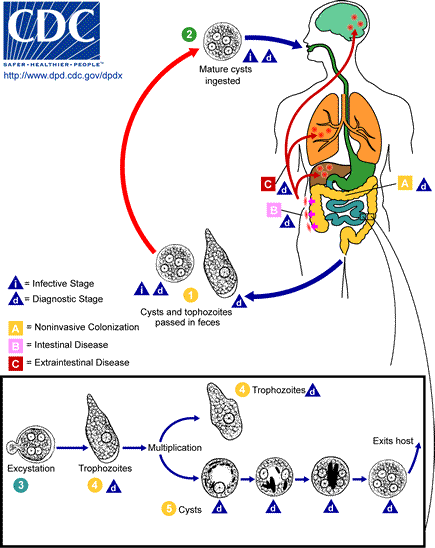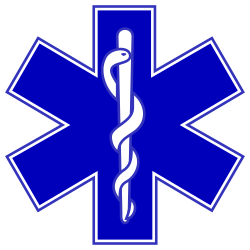Entamoeba histolytica Amebiasis LifeCycle
Amebiasis [Entamoeba histolytica]
Life Cycle of Entamoeba histolytica
Cysts and trophozoites are passed in feces . Cysts are typically found in formed stool, whereas trophozoites are typically found in diarrheal stool. Infection by Entamoeba histolytica occurs by ingestion of mature cysts in fecally contaminated food, water, or hands. Excystation occurs in the small intestine and trophozoites are released, which migrate to the large intestine. The trophozoites multiply by binary fission and produce cysts , and both stages are passed in the feces . Because of the protection conferred by their walls, the cysts can survive days to weeks in the external environment and are responsible for transmission. Trophozoites passed in the stool are rapidly destroyed once outside the body, and if ingested would not survive exposure to the gastric environment. In many cases, the trophozoites remain confined to the intestinal lumen ( : noninvasive infection) of individuals who are asymptomatic carriers, passing cysts in their stool. In some patients the trophozoites invade the intestinal mucosa ( : intestinal disease), or, through the bloodstream, extraintestinal sites such as the liver, brain, and lungs ( : extraintestinal disease), with resultant pathologic manifestations. It has been established that the invasive and noninvasive forms represent two separate species, respectively E. histolytica and E. dispar. These two species are morphologically indistinguishable unless E. histolytica is observed with ingested red blood cells (erythrophagocystosis). Transmission can also occur through exposure to fecal matter during sexual contact (in which case not only cysts, but also trophozoites could prove infective).Relevantní obrázky
Relevantní články
Měňavková úplaviceMěňavková úplavice, též amébní, respektive entamoební úplavice, je choroba způsobována měnavkou Entamoeba histolytica. Choroba se může vyskytovat jak bez příznaků, tak s mírnými, ale i těžkými. Symptomy pak mohou zahrnovat například bolest břicha, průjem. V důsledku ztráty tekutin může u postižených docházet k dehydrataci. U závažných forem pak i k chudokrevnosti v důsledků krevních ztrát. .. pokračovat ve čtení
Měňavka úplavičnáMěňavka úplavičná je parazitický prvok z říše Amoebozoa. Způsobuje lidskou měňavkovou úplavici a dále např. onemocnění jater. Vyskytuje se kosmopolitně, nejvíce však v rozvojových zemích, kde je rozšířená kvůli špatné hygieně a teplému a vlhkému klimatu. Hlavním hostitelem je člověk, ale infikováni mohou být vzácně i psi, kočky a hlodavci. Přenáší se alimentární cestou značně odolnými cystami. Nemá mezihostitele ani zvířecí rezervoár. Pokud napadne střevní sliznici, způsobuje střevní amébózu, invazivní kmeny mohou proniknout do tkání a způsobit extraintestinální amébózu. Většina infekcí je formou asymptomatického nosičství, pouze 10 % onemocnění je symptomatických. U dětí je invazivní amébóza velmi vzácná. .. pokračovat ve čtení


